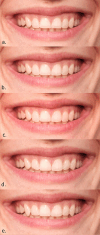Influence of education level and gender of dental students on perception of dental aesthetics
- PMID: 38549085
- PMCID: PMC10976696
- DOI: 10.1186/s12903-024-04115-x
Influence of education level and gender of dental students on perception of dental aesthetics
Abstract
Background: Fulfilling aesthetic norms is an imperative of modern society. Accordingly, aesthetics has found its important role in dental medicine. The aim was to study whether there is a difference in the perception of tooth shade change and anatomical variations of anterior maxillary teeth among dental students depending on the level of education, gender, and experience in assisting in a dental office.
Methods: The research was conducted among dental students via the Google Forms platform. Students evaluated the aesthetic acceptability of a smile on the unaltered, reference photograph (RP) and on the other 28 photographs in which the tooth shade (lighter and darker teeth), length (shortened central incisors, elongated, and beveled lateral incisors, elongated canines) and position (atypical and typical rotations and diastemas) of the upper maxillary teeth were altered by digital manipulation. The 1-10 assessment scale was used. Statistical analysis comprised one-way Kolmogorov-Smirnov test, X2 tests, t-test, and 3-way MANOVA.
Results: In the research 208 students participated, 113 were preclinical students, 104 assisted in dental office and 175 were females. There were no significant effects of gender regarding length and position modifications (p > .05), while women were stricter in evaluation of lighter shade (p < .05). Clinical students were stricter in evaluating all manipulated photographs (MP) except those towards darker shade modifications, while assisting in a dental office or having a dentist in close family showed no significant effects (p > .05).
Conclusions: With a higher level of targeted academic education, dental students sharpen their ability to notice deviations from the aesthetic norms of a smile.
Keywords: Assisting; Gender; Knowledge; Photograph modifications; Smile aesthetics; Targeted education.
© 2024. The Author(s).
Conflict of interest statement
The authors declare no competing interests.
Figures




Similar articles
-
Assessment of the perception of smile esthetics by laypersons, dental students and dental practitioners.Int Orthod. 2013 Dec;11(4):432-44. doi: 10.1016/j.ortho.2013.09.007. Int Orthod. 2013. PMID: 24427802 English, French.
-
Aesthetic evaluation of the labiolingual position of maxillary lateral incisors by orthodontists and laypersons.BMC Oral Health. 2021 Jan 22;21(1):42. doi: 10.1186/s12903-021-01402-9. BMC Oral Health. 2021. PMID: 33482798 Free PMC article.
-
Investigation of the esthetic perception of different canine parameters.Clin Oral Investig. 2022 Dec;26(12):6973-6983. doi: 10.1007/s00784-022-04651-2. Epub 2022 Jul 29. Clin Oral Investig. 2022. PMID: 35906341 Free PMC article.
-
[Esthetic proportions of maxillary anterior tooth among 300 normal occlusion college students in Shanxi province].Zhonghua Kou Qiang Yi Xue Za Zhi. 2022 Apr 9;57(4):352-357. doi: 10.3760/cma.j.cn112144-20210830-00389. Zhonghua Kou Qiang Yi Xue Za Zhi. 2022. PMID: 35368161 Chinese.
-
Width/Length Ratio in Maxillary Anterior Teeth. Comparative Study of Esthetic Preferences among Professionals and Laypersons.J Prosthodont. 2019 Apr;28(4):416-420. doi: 10.1111/jopr.12642. Epub 2017 May 17. J Prosthodont. 2019. PMID: 28513973
References
MeSH terms
LinkOut - more resources
Full Text Sources

